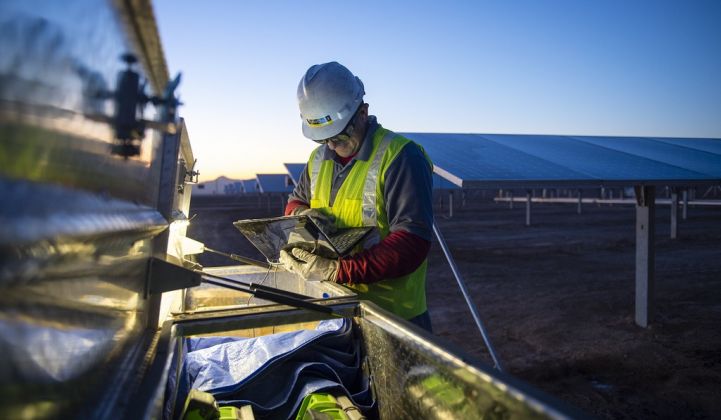A spate of recent acquisitions has left European oil and gas majors poised to become leaders in the solar market — with offshore wind also a growing focus.
The top tier of solar asset owners worldwide could change dramatically over the next 12 months due to the rapid ascent of a number of oil and gas companies, said Tom Heggarty, principal analyst in the energy transition practice at Wood Mackenzie.
France's Total, which controls SunPower and already had around 3 gigawatts of renewable generation assets before buying into a 2.1-gigawatt PV portfolio this month, will almost certainly be one of solar energy’s biggest asset holders. BP, Galp and Shell could also rank among the dozen or so leading solar generators, Heggarty said.
The oil and gas sector’s assault on the solar market is made easier by the fact that PV asset ownership is highly fragmented. The top 10 asset holders globally control around 10 percent of the 600 gigawatts or so of capacity installed worldwide.
Outside China, there are only a couple of dozen companies in the world with more than a gigawatt of solar capacity under ownership. At the end of 2018, the largest solar asset holder in the world outside of China was NextEra Energy, with some 4.5 gigawatts.
For comparison, Total’s solar portfolio today amounts to around 1.6 gigawatts. But in January, the French firm announced it would be building an 800-megawatt solar plant in Qatar, in collaboration with Marubeni.
And earlier this month, the oil major added a 2-gigawatt solar pipeline in Spain to its books. This run of acquisitions will make Total not only one of the biggest solar companies in the world but also one of the most geographically diverse, with assets across some 15 countries.
“There aren’t many companies that can match that geographical spread,” Heggarty said.
Total appears to have made solar the centerpiece of a strategy to get up to 20 percent of its revenues from low-carbon businesses by 2040. But other European oil companies are moving aggressively into the space too.
These include:
- BP, which has said it wants to become a net-zero carbon emitter by 2050, is already co-owner in one of the largest solar asset holders in the world thanks to its joint venture Lightsource BP, which aims to install 10 gigawatts by 2023.
- Galp Energia, the Portuguese oil company, which last month went straight into the top tier of solar players in Spain, Europe’s largest PV market, after paying $2.4 billion for 900 megawatts of operational assets and a pipeline expected to yield a further 2 gigawatts by 2023.
- Shell is expanding its solar footprint in locations such as the U.S., where it owns developer Silicon Ranch, and Australia, where it has a stake in Esco Pacific.
- Eni, of Italy, owns 49 percent of Falck Renewables’ 1 gigawatt U.S. solar pipeline and has 80 megawatts across 13 Italian plants.
- Equinor, the Norwegian oil and gas group, owns just over 15 percent of the PV developer Scatec Solar, which has 1.9 gigawatts of capacity in operation or under construction.
- Repsol, another oil company with net-zero emissions ambitions, is building several hundred megawatts of PV in Spain.
Oil companies moving on the wind market
Several of these European oil players are also moving decisively into wind, another relatively fragmented market, with around 20 percent of global capacity belonging to the top 10 asset owners.
Achieving leadership positions in onshore wind might be a stretch for oil companies in the short term, but Equinor and Shell already have big designs in the offshore market.
According to Feng Zhao, strategy director at the Global Wind Energy Council, Equinor has more than 320 megawatts of offshore wind capacity in the water and is working on a pipeline of 6 gigawatts, 4.6 gigawatts of which should be installed by 2025.
Shell, meanwhile, has more than 120 megawatts in operation and a 2025 pipeline of 1.8 gigawatts.
These pipelines would give Equinor and Shell around 6 percent of the world’s installed offshore wind capacity in 2025, based on market growth forecasts from the International Renewable Energy Agency.
Total is also moving into offshore wind, last year bidding — unsuccessfully — for a lease in France and then unveiling plans to move into the U.K. market.
When will American oil companies follow suit?
For all their recent investments, oil and gas companies' investments in renewables remain minuscule compared to what they spend overall. David Doherty, an oil specialist at the analyst firm BloombergNEF, said most majors are preoccupied with diversification into areas that could protect their core business. The sector is investing heavily in downstream operations across the Gulf Coast, he said.
For the same reason, almost all major oil companies have acquired stakes in electric vehicle charging startups, with a view to holding onto gas-station business in the transition to carbon-free mobility.
Only European oil firms have been compelled to buy into renewables in the face of growing shareholder pressure, he said. U.S. players such as Conoco and Exxon, which enjoy a more hands-off regulatory and shareholder climate, appear to be adopting a wait-and-see strategy.
However, Doherty said, the situation could change rapidly, causing U.S. majors to join the oil and gas land grab for renewable energy. A win for a progressive Democrat in this November’s U.S. elections “would put the fear into any Conoco or Exxon executive,” he said.




